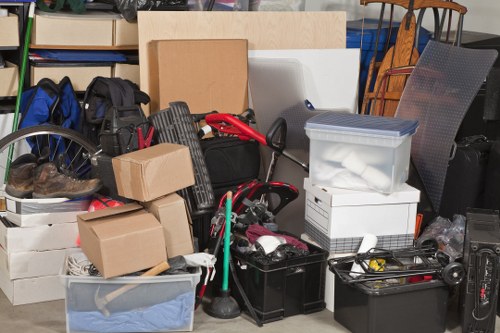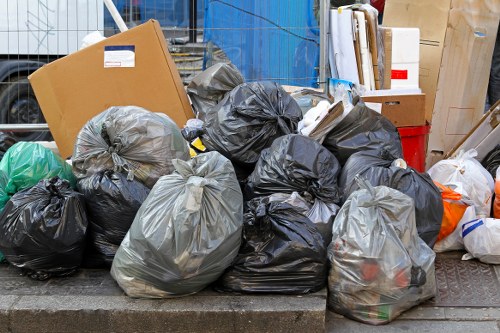Construction Waste Clearance in East Ham
Understanding Construction Waste Clearance

Construction projects, whether large or small, inevitably produce a significant amount of waste. Proper construction waste clearance is essential to maintain a safe and efficient work environment. In East Ham, managing construction waste effectively not only ensures compliance with local regulations but also contributes to environmental sustainability.
Construction waste includes materials like concrete, bricks, timber, metals, and plastics. Without proper clearance, these materials can lead to cluttered sites, increased hazard risks, and potential delays in project completion. Efficient waste management practices help in minimizing these issues, ensuring that construction projects run smoothly.
Moreover, responsible construction waste clearance can lead to cost savings. By recycling and reusing materials, contractors can reduce the expenses associated with waste disposal. This not only benefits the builders but also has a positive impact on the community by reducing the overall environmental footprint.
Why Choose Professional Services in East Ham?

Opting for professional construction waste clearance services in East Ham ensures that your waste is handled appropriately. These experts are equipped with the necessary tools and knowledge to manage different types of construction debris effectively. Their expertise ensures that all waste is disposed of in compliance with local laws and environmental guidelines.
Professional services also offer tailored solutions based on the specific needs of your construction project. Whether you are dealing with residential, commercial, or industrial waste, experienced clearance companies can provide customized strategies to manage and dispose of waste efficiently.
Additionally, utilizing professional services can save you valuable time and resources. Instead of dedicating your team to handle waste clearance, you can focus on core construction activities, thereby enhancing overall productivity and project timelines.
The Benefits of Efficient Waste Clearance

Efficient construction waste clearance offers numerous benefits, both economically and environmentally. Firstly, it helps in reducing the amount of waste sent to landfills, thereby minimizing the environmental impact. Recycling materials like metals, wood, and concrete not only conserves natural resources but also reduces the carbon footprint associated with manufacturing new materials.
Moreover, effective waste management can lead to significant cost reductions. By reusing materials, construction companies can lower their procurement costs, leading to more competitive project bids and increased profitability.
Furthermore, a well-organized waste clearance process enhances site safety. Removing debris promptly reduces the risk of accidents and injuries, creating a safer working environment for all personnel involved in the construction project.
Environmental Sustainability
Construction waste clearance plays a pivotal role in promoting environmental sustainability. By implementing green waste management practices, construction firms contribute to the conservation of ecosystems and biodiversity. Sustainable practices include segregating waste at the source, recycling materials, and utilizing eco-friendly disposal methods.
Reducing Landfill Usage
One of the primary environmental benefits of construction waste clearance is the reduction of landfill usage. Landfills are a significant source of greenhouse gas emissions, particularly methane, which is a potent greenhouse gas. By diverting waste from landfills through recycling and reuse, the overall environmental impact is significantly decreased.
Steps Involved in Construction Waste Clearance

The process of construction waste clearance involves several systematic steps to ensure efficiency and compliance. The first step is waste assessment, where the types and quantities of waste are identified. This assessment helps in planning the appropriate clearance strategy and selecting suitable disposal methods.
Following the assessment, the next step is waste segregation. Segregating waste at the source allows for easier recycling and disposal. Materials like concrete, wood, metals, and plastics should be separated to facilitate efficient processing.
The third step involves the actual waste removal. This includes the collection, transportation, and offloading of debris from the construction site. Professional services use specialized equipment and vehicles to handle large volumes of waste safely and efficiently.
Recycling and Disposal
After waste removal, the next phase is recycling and disposal. Materials that can be recycled are sent to appropriate facilities, while non-recyclable waste is disposed of in an environmentally responsible manner. This step ensures that waste clearance contributes to sustainability goals.
Compliance with Regulations
Adhering to local regulations is crucial in construction waste clearance. East Ham has specific guidelines and laws governing waste management practices. Professional clearance services ensure compliance with these regulations, avoiding potential fines and legal issues.
Choosing the Right Waste Clearance Service

Selecting the right construction waste clearance service in East Ham involves considering several factors. Experience is paramount; companies with a proven track record are more likely to deliver reliable and efficient services. Additionally, look for services that offer comprehensive solutions, including waste assessment, segregation, removal, and recycling.
Another critical factor is the company's commitment to sustainability. Opt for services that prioritize eco-friendly practices and utilize modern technologies to minimize environmental impact. Certifications and affiliations with environmental organizations can also be indicators of a company's dedication to sustainable waste management.
Cost is also an important consideration. While it's essential to stay within budget, compromising on quality can lead to long-term issues. Obtain quotes from multiple service providers and compare their offerings to ensure you receive the best value for your investment.
Customer Support and Flexibility
Effective customer support and flexibility are essential traits of a reliable waste clearance service. The ability to accommodate changes in project scope, provide timely responses, and offer personalized services can greatly enhance your experience. A company that values customer satisfaction is more likely to meet your specific needs and ensure a smooth waste clearance process.
Safety Standards
Safety should never be compromised in construction waste clearance. Ensure that the service provider adheres to strict safety standards and employs trained personnel. This not only protects your workforce but also ensures that waste is handled in a manner that prevents accidents and injuries.
Technology and Equipment
Modern technology and equipment play a significant role in efficient waste clearance. Services that invest in state-of-the-art machinery can handle large volumes of waste more effectively and reduce the time required for clearance. Additionally, advanced tracking systems can provide real-time updates on waste disposal, enhancing transparency and accountability.
Cost Factors in Construction Waste Clearance
The cost of construction waste clearance in East Ham can vary based on several factors. The volume and type of waste are primary determinants of the overall cost. Larger projects producing more waste will naturally incur higher clearance fees compared to smaller-scale projects.
Accessibility of the construction site is another crucial factor. Sites that are easily accessible allow for quicker and more efficient waste removal, potentially reducing costs. Conversely, sites with limited access or challenging terrains may require specialized equipment or additional labor, increasing the overall expense.
Additionally, the choice of disposal methods can impact costs. Recycling is often more cost-effective and environmentally friendly compared to landfilling. However, certain materials may require specific handling procedures, which can affect the total cost of clearance.
Transparent Pricing
Transparent pricing structures are essential when selecting a waste clearance service. Reputable companies provide detailed breakdowns of their fees, ensuring that there are no hidden costs. Understanding the pricing model helps in budgeting accurately and avoiding unexpected expenses during the project.
Cost-Saving Strategies
Implementing cost-saving strategies can help manage the expenses associated with construction waste clearance. One effective strategy is waste minimization, which involves reducing the amount of waste generated during construction. Efficient planning and material management can significantly decrease waste production, leading to lower clearance costs.
Negotiating Contracts
Negotiating contracts with waste clearance providers can also lead to cost savings. Discussing your specific needs and seeking discounts for long-term partnerships or bulk services can result in more favorable pricing agreements. Building a strong relationship with your service provider can open doors to customized offers and additional benefits.
Environmental Impact of Waste Clearance
Construction waste clearance has a profound impact on the environment. Proper management and disposal practices help in preserving natural resources and reducing pollution. By recycling materials, the demand for raw resources decreases, promoting sustainability and ecological balance.
Improper waste disposal, on the other hand, can lead to soil and water contamination, harming local ecosystems and public health. Ensuring that waste is handled responsibly prevents such adverse effects, contributing to a healthier and more sustainable environment in East Ham.
Furthermore, efficient waste clearance supports the circular economy model, where materials are continuously reused and repurposed. This approach minimizes waste production and maximizes resource utilization, fostering a sustainable and resilient community.
Community Benefits
Effective construction waste clearance also benefits the local community. Clean construction sites reduce visual pollution and enhance the aesthetics of the area. Additionally, minimizing waste traffic can alleviate road congestion and reduce emissions from transportation activities.
Regulatory Compliance
Adhering to environmental regulations is crucial for construction waste clearance. Compliance ensures that waste is managed in a manner that protects public health and the environment. Non-compliance can result in hefty fines, legal repercussions, and damage to a company's reputation.
Future of Waste Clearance
The future of construction waste clearance is geared towards greater sustainability and technological advancements. Innovations in waste processing, such as automated sorting systems and advanced recycling techniques, are set to revolutionize the industry. Embracing these advancements can lead to more efficient and eco-friendly waste management practices.
How to Get Started with Waste Clearance in East Ham
Initiating construction waste clearance for your project in East Ham involves several key steps. Start by assessing the amount and types of waste your project will generate. This assessment will help you determine the scope of services you require and facilitate better planning.
Next, research and identify reputable waste clearance companies in East Ham. Look for companies with positive reviews, relevant experience, and a commitment to sustainability. Request quotes and compare their services to find the best fit for your project needs and budget.
Once you have selected a service provider, discuss your project details and waste management requirements in detail. Clear communication ensures that all parties are aligned on expectations and deliverables, paving the way for a successful waste clearance process.
Scheduling and Logistics
Effective scheduling and logistics are essential for smooth waste clearance. Coordinate with your service provider to establish a timeline that aligns with your construction schedule. Ensure that the waste removal process does not disrupt ongoing construction activities.
Monitoring and Reporting
Monitor the waste clearance process to ensure it adheres to agreed-upon standards and timelines. Regular reporting and updates from the service provider can help track progress and address any issues promptly. This proactive approach ensures that waste clearance remains efficient and compliant throughout the project.
Continuous Improvement
After completing the waste clearance process, evaluate its effectiveness and identify areas for improvement. Gathering feedback from your team and the service provider can provide valuable insights into enhancing future waste management practices. Continuous improvement leads to more efficient and sustainable construction projects over time.
Innovations in Construction Waste Clearance
The construction industry is witnessing significant innovations aimed at improving waste clearance efficiency and sustainability. Advanced technologies, such as automated sorting systems and smart waste tracking, are transforming how waste is managed and processed.
Automated sorting systems utilize robotics and artificial intelligence to categorize and separate different types of waste quickly and accurately. This innovation increases the rate of recycling and minimizes human error, leading to more effective waste management.
Smart waste tracking systems provide real-time data on waste generation and disposal. These systems enable construction companies to monitor their waste clearance activities, ensuring transparency and accountability. By leveraging data analytics, companies can make informed decisions to optimize their waste management strategies.
Eco-Friendly Disposal Methods
Eco-friendly disposal methods are gaining traction in the construction waste clearance sector. Techniques such as bio-drying, which reduces the moisture content of waste through biological processes, and pyrolysis, which converts waste into fuel, are examples of sustainable waste management practices.
Recycling Technologies
Innovations in recycling technologies are enhancing the efficiency and scope of construction waste clearance. New methods allow for the recycling of complex materials, expanding the range of waste that can be repurposed. This advancement not only reduces the amount of waste sent to landfills but also supports the development of a circular economy.
Green Certifications
Obtaining green certifications is becoming increasingly important for construction waste clearance companies. Certifications, such as ISO 14001, demonstrate a company's commitment to environmental management and sustainability. Partnering with certified companies ensures that your waste clearance practices meet high environmental standards.
Case Studies: Successful Waste Clearance in East Ham
Numerous construction projects in East Ham have successfully implemented efficient waste clearance strategies, setting benchmarks for sustainability and cost-effectiveness. These case studies highlight the importance of proper planning, professional services, and innovative practices in achieving optimal waste management outcomes.
One notable example is the East Ham Riverside Development, where comprehensive waste clearance practices were employed. By integrating advanced recycling technologies and partnering with local waste management services, the project significantly reduced its environmental footprint and achieved timely completion.
Another success story is the East Ham Community Center project. The construction team collaborated with a professional waste clearance provider to implement effective waste segregation and recycling protocols. This collaboration not only ensured compliance with local regulations but also promoted community awareness about sustainable waste management.
Lessons Learned
These case studies provide valuable lessons for future construction projects. Key takeaways include the importance of early waste assessment, the benefits of partnering with experienced clearance services, and the positive impact of adopting sustainable practices. Applying these lessons can lead to more efficient and environmentally responsible construction waste clearance efforts.
Scalability of Solutions
Successful projects demonstrate that efficient waste clearance solutions are scalable and adaptable to different project sizes and types. Whether it's a small residential build or a large commercial development, the principles of effective waste management remain consistent. Scalability ensures that all construction projects can benefit from sustainable waste clearance practices.
Community Engagement
Engaging the local community in waste management initiatives fosters a culture of sustainability and responsibility. By involving community members in eco-friendly practices, construction projects can enhance their social impact and promote broader environmental awareness in East Ham.
The Future of Construction Waste Clearance in East Ham
The future of construction waste clearance in East Ham is poised for significant advancements, driven by technological innovations, stricter environmental regulations, and a growing emphasis on sustainability. As the construction industry continues to evolve, waste management practices will become increasingly sophisticated and integral to project success.
Emerging technologies, such as the Internet of Things (IoT) and artificial intelligence (AI), will play a crucial role in enhancing waste clearance efficiency. IoT devices can monitor waste levels in real-time, enabling proactive waste removal and reducing the risk of site congestion. AI algorithms can optimize waste sorting and recycling processes, increasing the rate of material recovery and reducing manual labor requirements.
Furthermore, the push towards zero-waste construction projects will drive the adoption of innovative waste management strategies. Construction companies will increasingly prioritize waste minimization, resource efficiency, and the use of recycled materials in their projects, leading to more sustainable and environmentally friendly construction practices.
Policy and Regulation
Government policies and regulations will continue to shape the landscape of construction waste clearance. Stricter regulations on waste disposal and recycling will compel construction companies to adopt more responsible waste management practices. Incentives for using recycled materials and penalties for non-compliance will further encourage sustainable waste clearance.
Collaboration and Partnerships
Collaboration between construction companies, waste management providers, and local authorities will be essential in advancing waste clearance initiatives. Partnerships can facilitate the sharing of resources, knowledge, and best practices, leading to more effective and widespread adoption of sustainable waste management techniques.
Education and Training
Education and training programs for construction workers and waste management professionals will be vital in promoting efficient waste clearance. By equipping individuals with the necessary skills and knowledge, the industry can ensure that waste management practices are implemented correctly and consistently across all projects.
Embracing Sustainability
Ultimately, the future of construction waste clearance in East Ham lies in embracing sustainability. By prioritizing eco-friendly practices, investing in innovative technologies, and fostering a culture of responsibility, the construction industry can achieve significant progress in reducing its environmental impact and promoting a sustainable future.
Technology Integration
Integrating advanced technologies into waste clearance operations will enhance efficiency and accuracy. Digital platforms can streamline waste tracking and reporting, providing valuable data for optimizing waste management strategies. Automation and robotics can further improve the speed and precision of waste sorting and recycling processes.
Long-Term Vision
Adopting a long-term vision for waste clearance ensures sustained progress towards environmental goals. Construction companies must commit to continuous improvement in their waste management practices, adapting to new technologies and evolving regulations to maintain high standards of sustainability and efficiency.
Conclusion: Prioritizing Waste Clearance for a Sustainable East Ham
Construction waste clearance is a critical component of any construction project in East Ham. By implementing efficient and responsible waste management practices, construction companies can enhance project outcomes, reduce environmental impact, and contribute to the overall sustainability of the community.
Choosing professional waste clearance services ensures compliance with regulations, promotes recycling and reuse, and fosters a safer working environment. The benefits of effective waste clearance extend beyond the construction site, positively impacting the local environment and economy.
As the construction industry continues to evolve, embracing innovative technologies and sustainable practices will be essential in advancing waste management efforts. By prioritizing construction waste clearance, East Ham can build a more sustainable and resilient future for all its residents.
Take Action Today
Don't let construction waste hinder your project's success. Contact us today to learn how our professional waste clearance services in East Ham can help streamline your operations and promote sustainability.
Book Your Service Now
Ready to enhance your construction project's efficiency and environmental responsibility? Book your construction waste clearance service now and take the first step towards a cleaner, greener East Ham.